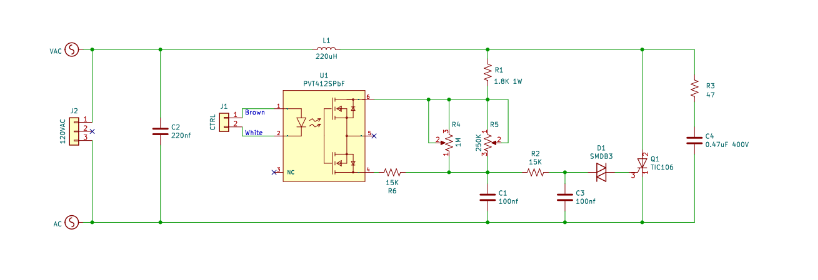I guess it is due to a bad switching/control circuit, it is a nice idea the circuit you proposed, but it wouldn't work with pwm input sadly, there is an appropriate driving circuit (using Phase Control) that will be explained below, but first, let's look at the triac.
TRIAC
A TRIAC cannot be turned off using the control voltage once it has been triggered (turned on) during a half-cycle of the AC waveform. Instead, it remains on until the current through it naturally drops below a certain threshold (the holding current), which usually happens when the AC voltage crosses zero (the zero crossing point).
In other words:
- Once the TRIAC is turned on, it conducts for the remainder of the AC half-cycle.
- It can only turn off when the AC voltage reaches zero (during the natural zero crossing).
- To control when it turns on again, you need to manage the triggering at each half-cycle.
If the TRIAC is not switching efficiently, it might be contributing to improper voltage or current regulation at lower speeds. For example, if the TRIAC is not turning on and off properly due to poor gate triggering from the PWM signal, it could lead to improper current flow and increased heat dissipation.
Ripple Current
When operating at lower speeds, especially with AC motors, high ripple current can cause significant heating in both the motor windings and the TRIAC. This can overload the fan’s thermal protection if not properly managed.
Ripple current refers to the AC component of the current that "ripples" on top of the average (DC) current, particularly when a switching power supply or PWM control is involved. It’s important in motors because large ripple currents cause extra heating and stress on the windings and components.
Why Increasing PWM Frequency Won't Help:
Once the TRIAC is triggered, it will conduct until the current reaches zero, regardless of how fast the PWM signal is switching.
If the PWM frequency is too high, you could end up attempting to trigger the TRIAC multiple times within a single AC half-cycle, but it would have no effect, since the TRIAC is already on. This makes high-frequency PWM ineffective for precise control with TRIACs.
Proposed Solution:
You can control the phase angle at which the TRIAC is triggered in each AC cycle. By delaying the TRIAC's turn-on point relative to the AC zero crossing, you control the amount of power delivered to the load (motor). This is the standard approach for dimming lights or controlling motor speeds using a TRIAC.
There are many methods to implement this circuit, either by using microcontrollers or without them. Below is a simple phase control circuit example without microcontrollers:

Circuit Operation:
Initial Condition: When the AC voltage starts a new half-cycle, the capacitor C1 begins to charge through the resistors R1 and R2.
Capacitor Charging: The charging time of C1 is controlled by the resistance values of R1 and R2 . As the capacitor charges, the voltage across it increases.
DIAC Triggering: Once the capacitor voltage VC1 reaches the breakover voltage of the DIAC (D1), the DIAC turns on. This discharges
C1 rapidly and sends a current pulse to the gate of the TRIAC (Q1). The TRIAC is then triggered into conduction.
TRIAC Conduction: After the TRIAC is triggered by the gate pulse, it remains on for the rest of that AC half-cycle. The TRIAC will turn off only when the current through it drops below the holding current, which happens at the next zero crossing of the AC voltage.
Phase Control: The moment the TRIAC is triggered (relative to the AC cycle) determines how long it stays on during each half-cycle. Adjusting the resistance values (usually using a potentiometer) is the point at which the DIAC fires can be changed, thereby altering the amount of power delivered to the load. This is how the circuit controls the phase angle.
Additionally, if you would like to take control over with a microcontroller you would need to implement some zero-crossing detector circuit to sync the control signals with the AC power supply.

full doc: https://www.ti.com/lit/ab/snoa999/snoa999.pdf?ts=1726615394606







Motor type ACfalls short of being illuminative. I think the RPM low for an induction machine@60 Hz, power factor low for a universal machine that size. \$\endgroup\$